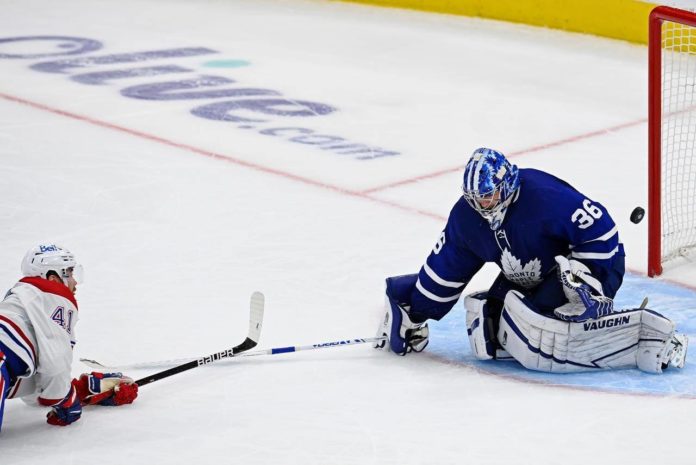
Cursed game, cursed team.
There’s nothing I enjoy more than breaking down the nuances of Maple Leafs hockey, especially now that they’re in a big playoff matchup against the Montreal Canadiens. There was legitimate buzz around the city as I was driving downtown today! Unfortunately, the tactical side of my brain was in shambles after watching John Tavares struggle to get up following an inadvertent knee to the head.
It’s one of the worst collisions I’ve seen in recent memory, genuinely making me feel sick to my stomach every time they slowed down the replay on the broadcast. For that reason, we won’t be showing the incident that resulted in Toronto’s captain being carted off the ice in a stretcher.
Unsurprisingly, that sucked the life out of the building. The Leafs really struggled to generate momentum after the injury, quickly giving up a breakaway goal. Despite some strong offensive play from their big guns, Toronto’s struggling power play cost them again tonight, allowing a short-handed goal that ended up being the game-winner.
There’s no way to sugarcoat it — this was a nightmare scenario for the Leafs. In our attempt to break things down (somewhat) rationally, here’s a quick blueprint for what to expect.
Really excited to shake things up with my post-game Leafs analysis throughout the playoffs.
Instead of grading each player individually, I'll be breaking down key tactical adjustments, noteworthy performances + clips, and what to keep an eye on for the next game.
Here we go! 😀
— Ian Tulloch📊 (@IanGraph) May 20, 2021
I’m not nearly as excited now as I was before puck-drop, but alas, it’s time for some post-game Leafs analysis. Let’s try our best here, folks!
Noteworthy Performances
Instead of grading every single player individually — and struggling to come up with words for the Alex Kerfoots of the world — my editor and I decided it would be best to focus on the most noteworthy Leafs from Game 1. This should help us save some ink for the guys we’re all actually interested in breaking down, so let’s start with Toronto’s most impactful player.
Auston Matthews was clearly in fine form tonight, leading the team with 13 shot attempts and seven chances from the slot. He was an absolute machine gun on offense, getting himself into open ice so he could uncork one-timer after one-timer on Carey Price.
Somehow, he failed to find the back of the net, but good things are going to happen when you’re generating that many chances. It was also nice to see Matthews throwing his weight around in puck battles, using his 220-pound frame to win body position along the boards. As great as Philip Danault is defensively, he’s going to have a hard time winning 50-50 pucks in the trenches if Matthews maintains this level of physicality.
The other two players I wanted to bring up are William Nylander and Morgan Rielly. A major theme we’ll be discussing is the lack of transition offense Toronto was able to generate in comparison to Montreal. The Canadiens did an excellent job of clogging up the neutral zone, killing plays early before the Leafs had a chance to build up speed.
Nylander and Rielly were the exceptions to this. Both players were able to push play in transition, using their combination of puck skills and foot-speed to beat their man up the ice and create some high-percentage chances for Toronto off the rush. Other than Matthews, they were the only two Leafs creating much of anything offensively at 5-on-5, with Nylander eventually converting on a rebound goal off a Rielly point shot.
As critical as I’ve been of Rielly defensively this year, tonight might have been his best game on that side of the ice. He played a tight gap in transition defense, handled 1-on-1 rushes well, and even prevented a goal with a kick-save and a beauty.
More of these types of performances, please!
Another player I feel obliged to bring up is Nick Foligno, who provided value in more ways than one. If we stick to the actual whistle-to-whistle analysis, he was winning the majority of his puck battles along the boards, which helped get Nylander into open ice. As always, Foligno was in the right spots defensively, helping his teammates get the puck back in all three zones.
Foligno deserves full credit for that Leafs goal. Good pick up in NZ, gets it deep, disrupts forecheck on breakout, screen in front draws two. Set the table.
— Justin Bourne (@jtbourne) May 21, 2021
Let’s face it, though, it was the extra curriculars that got Leafs fans riled up tonight. I’m not here to decide whether or not he needed to fight Perry, but I can guarantee you his teammates appreciated the pushback after watching their captain get stretchered off.
In a similar vein, Foligno getting into it with a few Canadiens after the whistle is exactly what you want to see in a playoff series. Standing up for your teammates is an aspect of hockey that’s difficult to measure, but even the nerdiest part of me knows it has value.
To quickly wrap up a few more players, Jack Campbell looked solid in his crease, controlling rebounds on even the hardest of slap shots. He did allow two breakaway goals, but I’d pin that more on Joe Thornton for turning the puck over and Rasmus Sandin getting beat down the ice on both occasions. Campbell went 28 for 28 on the other shots he faced, which I’d say is pretty solid.
Last but not least, Riley Nash looked like…Riley Nash. He’s historically been a player where scoring chances go to die on both sides of the rink. His final tally tonight at 5v5? One scoring chance for, one scoring chance against.
If you expected anything more or less from him, frankly, you haven’t been paying attention throughout his career. He’s a low-event player.
The Video Room
Again, we won’t be showing the Tavares incident because watching it once made me uncomfortable enough. Seeing it in slow-motion multiple times on the broadcast was just overkill. If you happened to miss the hit, you can watch it here, although I’d advise against it if you’re squeamish.
Something about Kyle Dubas rushing to John Tavares hit me hard. pic.twitter.com/ExrUm4wyy2
— alberto (@twistedleafs) May 21, 2021
If you’ve ever had a family member in the hospital, this had a similar panic feeling to it. Even trying to analyze this game as if it were your typical Game 1 just seems foolish to me. NHL players are human beings too, so I can only imagine how hard it was for the Leafs to find their groove again after watching their captain buckle to the ice. It’s one of the only times I’ve been scared watching a Leafs game.
Then again, it’s the players’ job to put emotions aside and compete to the best of their ability. In similar fashion, I’ll try my best to break down the video footage I found most interesting in this game, even though I can honestly say my heart just wasn’t in it tonight.
The Josh Anderson Problem
A subheading with that title would make you think he was running around, throwing elbows, crashing the crease, and wreaking havoc after the whistle. Nope, I’m referring to the rush chances he was able to generate early and often with his speed.
Let’s take a look at his first one.
Justin Holl hops on the ice a bit late here, which allows Anderson to beat him backdoor for the Grade-A scoring chance.
A few minutes later, the Canadiens try a similar play to get #17 in behind the Leafs’ defense.
The pass is a bit off, but once again, Anderson sneaks in behind the last defender with a burst of speed and finds himself in a perfect position to score a backdoor goal.
Soon afterward, he capitalizes on a Leafs turnover, burning the Sandin-Bogosian pairing for a breakaway goal.
I won’t keep beating this dead horse, but Anderson did slice through Toronto’s defense again on the power play later on in the game, earning himself a partial breakaway.
What’s interesting about Montreal is that they can actually be a dangerous offensive team when they get opportunities off the rush. They really struggle to create high-percentage chances off the cycle, relying mostly on point shots, but when speedy players like Anderson or Paul Byron find themselves in open ice, you’re in trouble.
Knowing this, the Habs made a concerted effort to spread the ice vertically with stretch passes in attempt to get their forwards down the rink in 1-on-1 or 2-on-2 situations.
The pass didn’t connect here, but Toronto needs to do a much better job of preventing these high-value plays if they’re going to get back in this series. For reference, rush chances were 5-1 in Montreal’s favour after two periods. The most efficient offense in the NHL is created off the rush, which is why it’s so crucial for Toronto to address this problem in their upcoming games.
If they can force the Habs to grind out more possessions in the offensive zone, the shot locations should end up looking more like this.
Data from HockeyViz.com
All those red blobs from the point indicate that Montreal generated most of their offense from the blue line this season, whereas Toronto was able to penetrate the slot much more often.
Tactical Adjustments
Lineup Construction
Losing your $11 million dollar center halfway through the first period of Game 1 forces you to make some major adjustments. Here’s what Sheldon Keefe ended up running with for the most part after the Tavares injury.
Hyman-Matthews-Marner
Foligno-Kerfoot-Nylander
Mikheyev-Nash
Thornton-Spezza-Simmonds
We saw some bouncing around early on, with Thornton getting a shift or two at center. Alex Kerfoot was also moving around, filling in on the Mikheyev-Nash line sometimes, and other times Wayne Simmonds taking that spot.
The good news is that Toronto’s top line dominated Montreal at even strength, especially when they shared the ice with Rielly. Dominique Ducharme tried to match up Danault and the Edmundson-Petry pairing against Matthews & Company to no avail. Shea Weber was noticeably sheltered tonight, still nursing a wrist injury that doesn’t look like it’s fully healed. That’s definitely something to keep a close eye on moving forward.
The bad news is that Toronto’s other lines didn’t look great. Every time Kerfoot was on the ice, the Leafs were getting badly out-chanced at 5v5, which has been the case for him all season. The veteran line of Thornton-Spezza-Simmonds didn’t fare much better, making me wonder if we see some significant changes in Game 2.
I’d imagine Pierre Engvall draws into the lineup based on his recent play, but is there a chance we also see Alex Galchenyuk? Someone else would need to be scratched to make that happen, which is why I’d suggest taking out either Alex Kerfoot or one of the veterans on that fourth line not named Jason Spezza.
Kerfoot provides some 4v5 value, but he’s been a complete liability at 5v5 this season. The Leafs have plenty of forwards who can kill penalties, whether it’s Engvall, Nash, or Foligno, so why not take out one of your weakest 5v5 players of 2021 and replace them with someone who’s more effective at even strength?
This is a side-note, but William Nylander is the superior 2C option. It’s too bad he didn’t get any reps there this season in preparation for an injury down-the-middle. Now, you could point to his rough Game 5 last year in the playoffs. You could also point to the large sample of him succeeding as an NHL center at 5v5, especially when he’s playing alongside a defensively responsible winger (i.e. Hyman or Foligno).
It might be time to sit one of Thornton or Simmonds, but realistically, knowing their impact in the room, we’d probably need to see another game or two of them getting shelled at 5v5 before that happens.
The Power Play
What’s funny is that Toronto’s first look on the power play was promising. Sandin was walking the line well, getting the puck to Matthews on his off-wing for multiple one-timers. He even hit the post from that side of the ice.
The frustrating aspect of Toronto’s power play is that Thornton, once again, found himself in the PP1 bumper spot. I can’t for the life of me understand why the Leafs keep trying this, since he’s one of the least threatening shooters in the NHL, allowing opposing PKs to sag off of him and put more pressure on Toronto’s skilled players along the perimeter.
Another thing to think about is just how often the Leafs are putting Mitch Marner in shooting positions. Everyone knows he’s an all-world passer, but everyone also knows that he isn’t much of a shot threat from the top of the circle. I doubt they take their $11 million winger off of PP1, but maybe Nylander should be getting more looks in that spot with Marner on the goal-line, since that gives you more of a credible shooter from the half-wall.
Penalty Kill
This was the one sign of optimism for the Leafs tonight. Despite TJ Brodie getting burned a couple of times, the team did an excellent job of forming a wall at the blue line and preventing clean entries. Montreal had a difficult time getting their power play set up in formation, which is when you know you’re doing your job as a penalty kill unit.
Some of that was thanks to Ilya Mikheyev reading the drop-pass play, hovering around the puck carrier while preventing the drop-pass everyone knows is coming. It also helps having Marner pick off passes in the defensive zone, or Jake Muzzin throwing a big hit on Brendan Gallagher when he got the opportunity. Heck, even Nash was disruptive as a forechecker.
If you’re a Leafs fan — and I assume you are because you’re still reading this — you have plenty of reasons to be concerned right now, but for once, the PK isn’t anywhere near the top of that list.
You’ve got to think Cole Caufield joins PP1 in the very near future, which should give the Habs a better weapon from the left dot, but then again, Ducharme seems to hate the idea of playing his kids. Maybe he’ll do the Leafs a favour and keep his talented youngsters in the press box.
Stats of the Night
Anyone who’s read my work over the years should know by now that I love using data to help guide my analysis. Hockey can be such a chaotic sport that sometimes we get lost in the madness, so it helps to have some kind of objective evidence to back up what we’re seeing.
I’ve already mentioned the rush chances, which were significantly in Montreal’s favour, but even if we look at something as simple as “scoring chances” — or shots from the slot — Toronto only controlled 45% of those at 5v5 tonight according to Natural Stat Trick.
It doesn’t help when Kerfoot gets out-chanced 2-6 or the Thornton-Simmonds duo give up five slot shots while generating zero. Those players aren’t your difference makers up front, but when you’re a team trying to compete for a cup, you need your depth players to come closer to breaking even if you’re going to make a deep run.
I’ve always liked sharing the following table after the games to help myself keep track of the individual and on-ice metrics.
You don’t want to get carried away with one-game samples. Then again, when a player like Kerfoot is the only active Leaf to get out-chanced in his 661 minutes at even strength this season, you have to ask yourself why he’s still on the active roster in must-win games.
Things to keep an eye on
Let’s wrap things up here by admitting the obvious: tonight was a soul-crushing loss for the Leafs. The team looked deflated after the Tavares incident, with all of us watching and immediately thinking “insert swear word, I hope he’s okay.” The good news is that he appears to be doing well in the hospital right now.
Sheldon Keefe says John Tavares is conscious and communicating well…will remain in hospital overnight. Tests have come back "clear."
— Elliotte Friedman (@FriedgeHNIC) May 21, 2021
Looking ahead to Game 2, it’s going to be paramount that the Leafs address the transition issues that we discussed. They aren’t going to beat the Canadiens if they continue to get out-chanced off the rush by a significant margin, which is why they’ll need to shore up their transition defense and find a way to move the puck up the ice more efficiently.
Both of those were areas of strength for Toronto, which makes me wonder if they can shore up those areas without Tavares. Only time will tell, but keep a close eye on the neutral zone as this series progresses. I have a good feeling whichever team wins the battle between the blue lines will come out victorious in this series.
Well, that and whoever has the best save percentage.


![Sheldon Keefe on the Maple Leafs’ struggling power play: “[We’ve scored] one out of 11 high-danger chances in tight to the net… We have been in those spots and haven’t converted” Sheldon Keefe, playoff press conference](https://mapleleafshotstove.com/wp-content/uploads/2024/04/keefe-pc-game-3-218x150.jpg)

![Jim Montgomery Post Game, Bruins 4 vs. Leafs 2: “[Marchand] still manages to get under people’s skin, yet he doesn’t cross the line” Jim Montgomery, Boston Bruins post game](https://mapleleafshotstove.com/wp-content/uploads/2024/04/jim-monty-pg-to-218x150.jpg)




















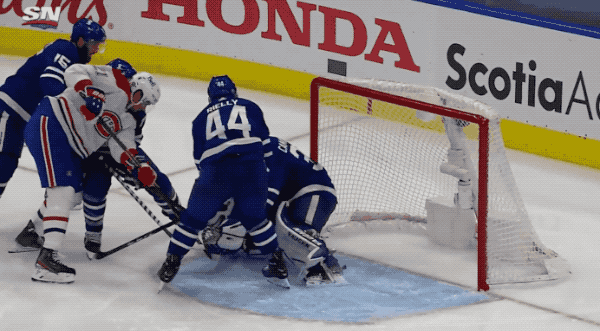
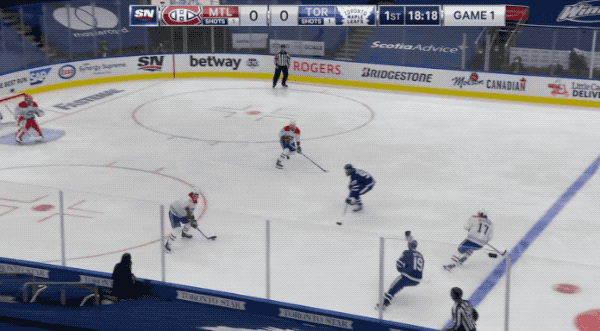
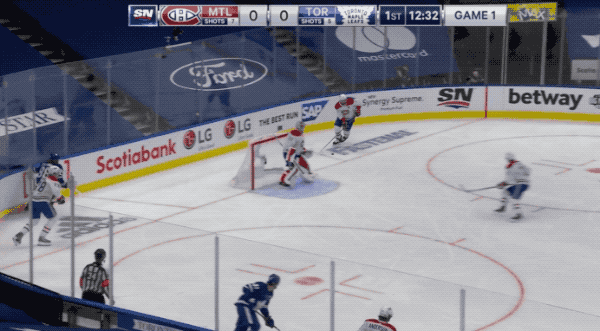
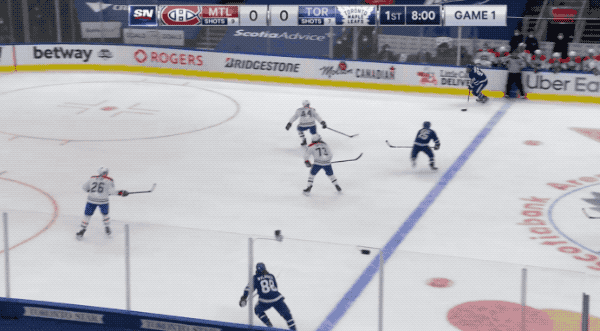

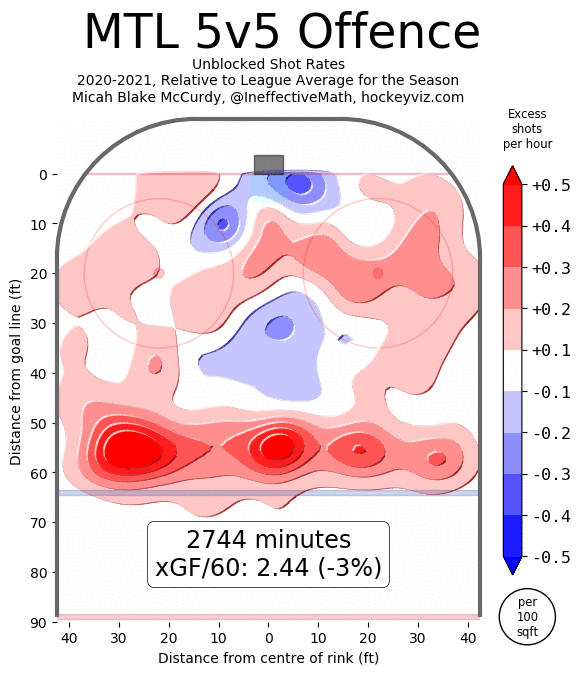
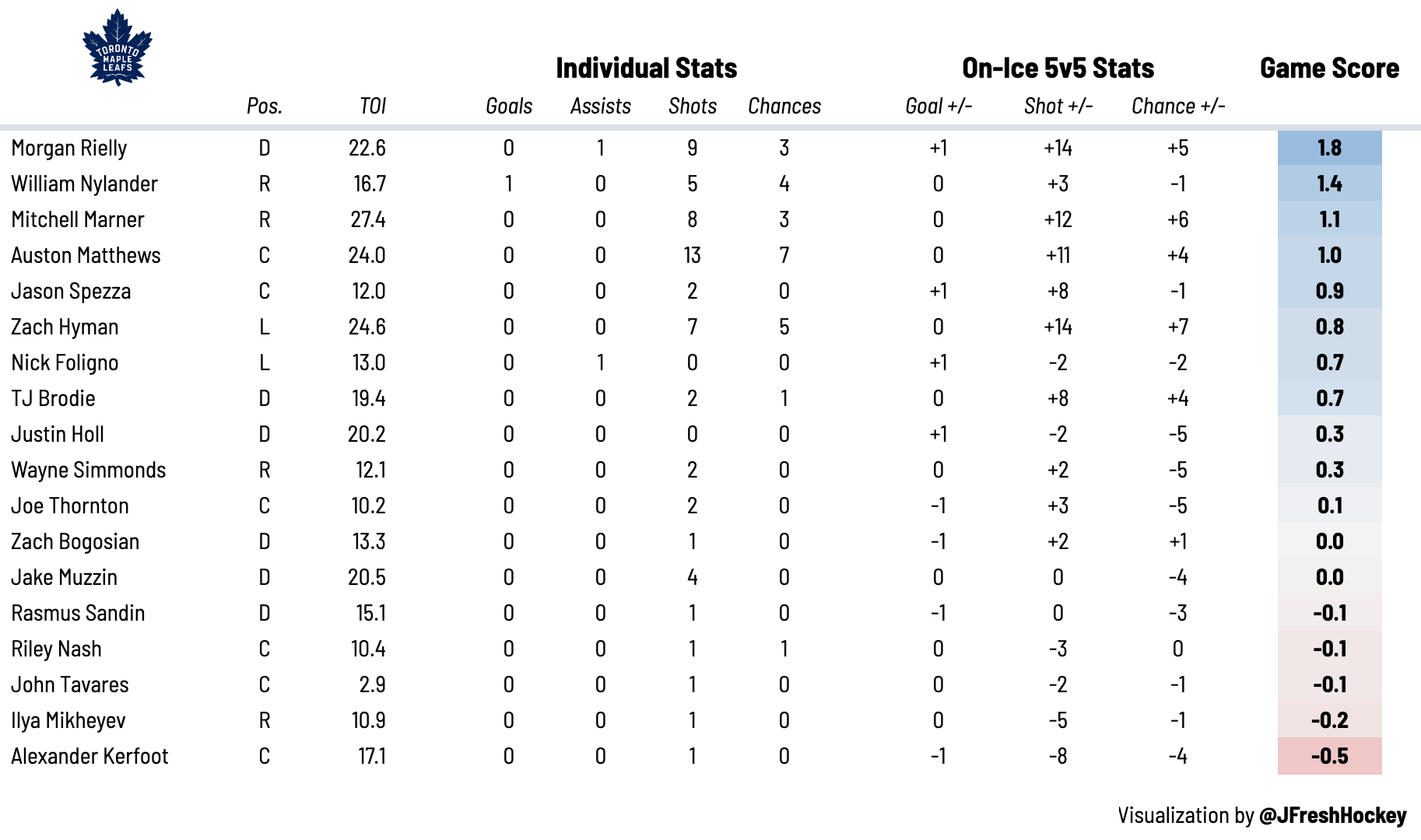


![Sheldon Keefe on the Maple Leafs’ struggling power play: “[We’ve scored] one out of 11 high-danger chances in tight to the net… We have been in those spots and haven’t converted” Sheldon Keefe, playoff press conference](https://mapleleafshotstove.com/wp-content/uploads/2024/04/keefe-pc-game-3-100x70.jpg)



![Jim Montgomery Post Game, Bruins 4 vs. Leafs 2: “[Marchand] still manages to get under people’s skin, yet he doesn’t cross the line” Jim Montgomery, Boston Bruins post game](https://mapleleafshotstove.com/wp-content/uploads/2024/04/jim-monty-pg-to-100x70.jpg)

